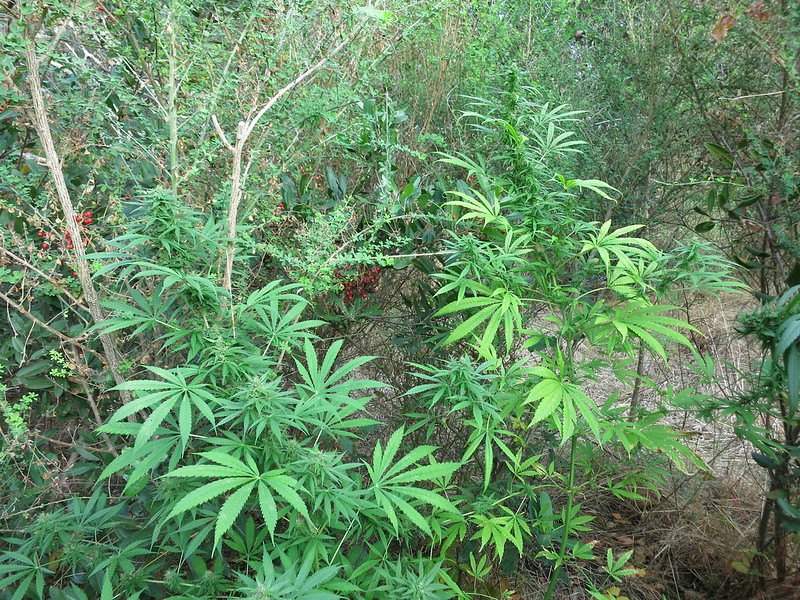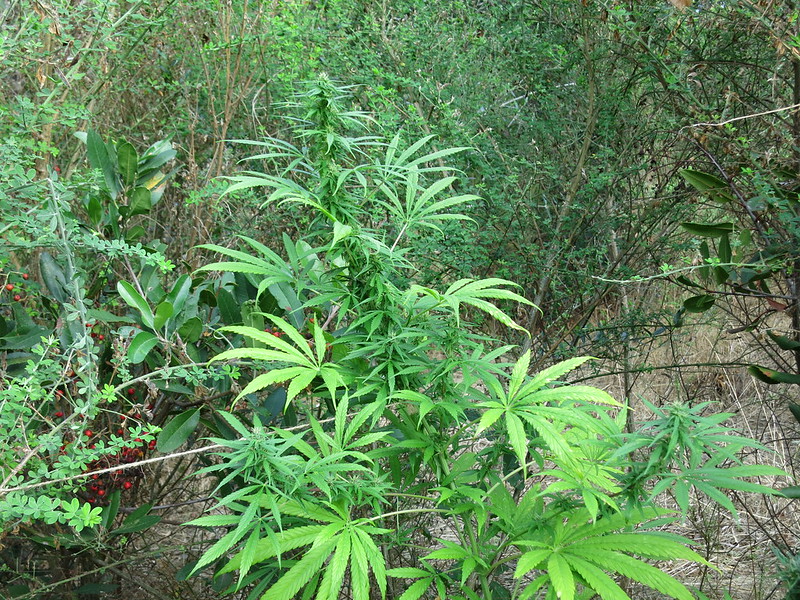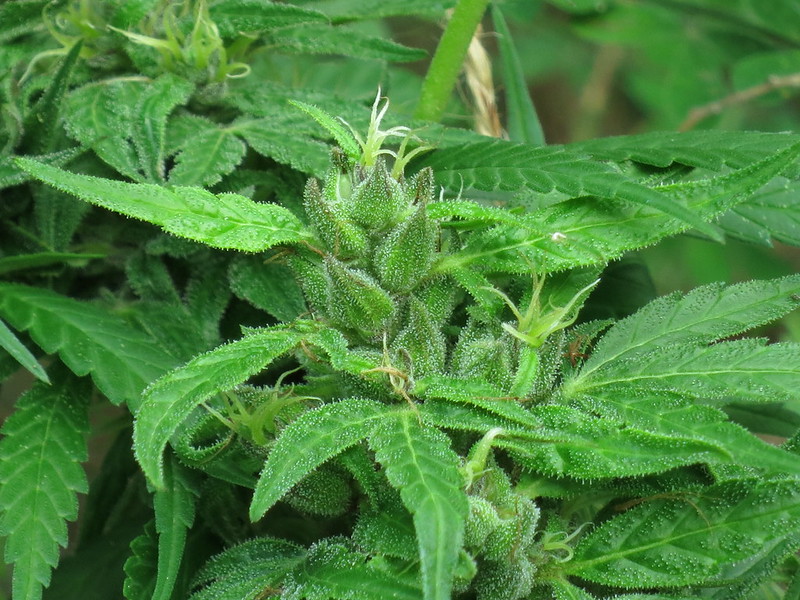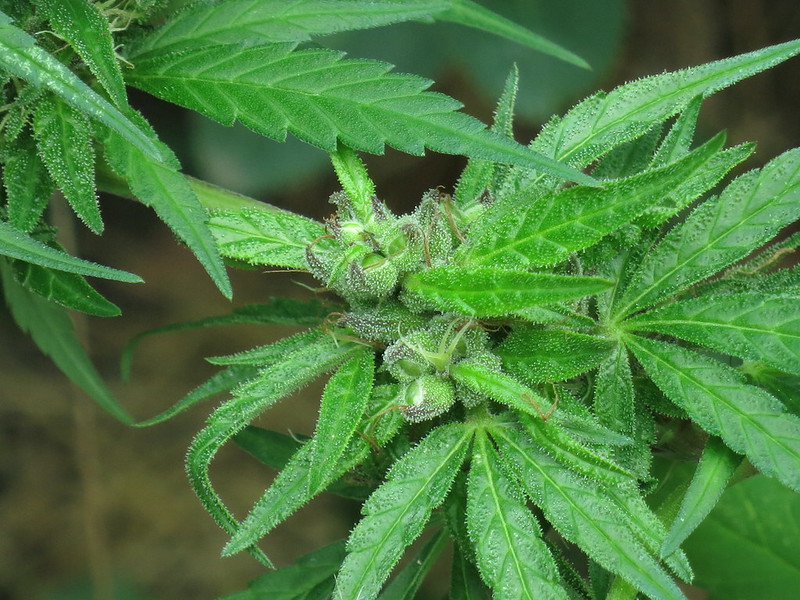-
Happy Birthday ICMag! Been 20 years since Gypsy Nirvana created the forum! We are celebrating with a 4/20 Giveaway and by launching a new Patreon tier called "420club". You can read more here.
-
Important notice: ICMag's T.O.U. has been updated. Please review it here. For your convenience, it is also available in the main forum menu, under 'Quick Links"!
You are using an out of date browser. It may not display this or other websites correctly.
You should upgrade or use an alternative browser.
You should upgrade or use an alternative browser.
Manipuri
- Thread starter Genghis Kush
- Start date
Thanks for the encouragement Green!
Well, the manipuri plants are still hanging in there despite consistently cold weather, high humidity, and lots of rain. It looks like the seeds will probably make it to maturity at this rate, but I'm not counting on getting mature flowers. The aroma on both plants are very similar, but at this stage of development, it doesn't seem to be much like citrus. It's really hard to describe, but I've smelled this exact aroma on a nepalese Sativa variant. In any case, it's very sweet, pungent, and smells delicious!
To the right is the earlier maturing indivdual, and to the left, the later maturing/nutrient sensitive plant. This gives you an idea of the overall structure of this variety, they're gorgeous!

Closer shot of the later maturing plant:

Maturing seed pods and you can also see some resin glands. There must be hundreds of seeds on this plant, probably went a little too crazy on it:

calyx starting to turn purple from cold stress, this picture was taken a week or two before the shots above:

Well, the manipuri plants are still hanging in there despite consistently cold weather, high humidity, and lots of rain. It looks like the seeds will probably make it to maturity at this rate, but I'm not counting on getting mature flowers. The aroma on both plants are very similar, but at this stage of development, it doesn't seem to be much like citrus. It's really hard to describe, but I've smelled this exact aroma on a nepalese Sativa variant. In any case, it's very sweet, pungent, and smells delicious!
To the right is the earlier maturing indivdual, and to the left, the later maturing/nutrient sensitive plant. This gives you an idea of the overall structure of this variety, they're gorgeous!

Closer shot of the later maturing plant:

Maturing seed pods and you can also see some resin glands. There must be hundreds of seeds on this plant, probably went a little too crazy on it:

calyx starting to turn purple from cold stress, this picture was taken a week or two before the shots above:

W
Water-
Thsnks for the pics and info meizzwang.
Looks great!!
Looks great!!
Truhan
Member
Very good work friend. The Manipuri are very resistant to rain, but not to cold. The low temperatures stress them a lot, which affects the thickness of the flowers and the beautiful tones that it develops.
Manipuri is a beautiful plant that has been in my garden for 3 years.
flowering is very slow in some phenotypes, especially one that expresses itself in the form of a vine. They are plants that exceed 16 weeks of flowering, very easily.
However, the most outstanding feature of this cultivar is how slow they are, when it comes to showing their sex. most of them go beyond 4 months, without even showing signs of their sexuality. I have cultivated many landraces, including the slow thailand, and nothing is slower than the manipuri, when it comes to showing their sex.
the manipuri is a variety for foodies and growers, for those who appreciate the plants. A great job of selecting the Meitei people.
regards
: tiphat:
Manipuri is a beautiful plant that has been in my garden for 3 years.
flowering is very slow in some phenotypes, especially one that expresses itself in the form of a vine. They are plants that exceed 16 weeks of flowering, very easily.
However, the most outstanding feature of this cultivar is how slow they are, when it comes to showing their sex. most of them go beyond 4 months, without even showing signs of their sexuality. I have cultivated many landraces, including the slow thailand, and nothing is slower than the manipuri, when it comes to showing their sex.
the manipuri is a variety for foodies and growers, for those who appreciate the plants. A great job of selecting the Meitei people.
regards
: tiphat:
Truhan
Member
The appearance of hermaphroditic individuals is common in the manipuri. Low temperatures and stress conditions directly influence the appearance of hermaphroditic plants.
This condition has been presented to me in two ways, males who have developed then female and female flowers that have then developed the occasional male flower.
As the plant that I show next
thanks for sharing Truhan! Regarding hermaphrodites, I'm finding the "terminal bract" male flower is very common in many unworked landraces, including (but not limited to) malana, nanda devi, kumaoni, malawi gold, and Lebanese (higher frequency than the others). It makes sense too, the nanners show up about 2 weeks before harvest and many times, they're difficult to see, so it's understandable that unless the original growers are sophisticated, they won't select against these traits. Full blown uncontrollable hermis are less common, probably because they're easy to ID during preflowering and can therefore be easily cull before they become a problem.
Despite temperatures going down to about 4C at night and being exposed to heavy rain for many days in a row, the manipuris are still showing no signs of botrytis! In contrast, Kumaoni showed a little bit of botrytis under the same conditions and was subsequently chopped a little bit early. We'll see how the manipuris handle more cold. At this rate, the earliest flowering plant is predicted to finish mid December, if it can make it that long!
Despite temperatures going down to about 4C at night and being exposed to heavy rain for many days in a row, the manipuris are still showing no signs of botrytis! In contrast, Kumaoni showed a little bit of botrytis under the same conditions and was subsequently chopped a little bit early. We'll see how the manipuris handle more cold. At this rate, the earliest flowering plant is predicted to finish mid December, if it can make it that long!
I like those buds Truhan. How is the high from this? Must be good as you kept it 3 years.
You said 'foodies and growers', not understanding what you meant. You mean patient growers and those that want a special high or taste?
Does it lean sativa or indica in effect? Up or down is effect. Any trippy feel to it?
You said 'foodies and growers', not understanding what you meant. You mean patient growers and those that want a special high or taste?
Does it lean sativa or indica in effect? Up or down is effect. Any trippy feel to it?
Truhan
Member
I like those buds Truhan. How is the high from this? Must be good as you kept it 3 years.
You said 'foodies and growers', not understanding what you meant. You mean patient growers and those that want a special high or taste?
Does it lean sativa or indica in effect? Up or down is effect. Any trippy feel to it?
hello friend, the fucking translator plays tricks on me.
But I wanted to say what you have very well interpreted.
Its effect is very high, very sativa, euphoric and lasting. I still do not give the plant that has a more indica effect.
The smoke is wonderful, very nice. It is a guard herb. if you smoke it before 4 months, it tastes like grass. You have to give it a long cure. And all the magic of this cultivar will appear.
I am a cultivator of landraces, I have cultivated several things of TRSC, and the manipuri has surprised me a lot. The plant has a character a huge personality. I have learned a lot cultivating it, the plant has taught me several things.
It is a huge genetic legacy the manipuri. A great work of the Meitei people.
regards
Truhan
Member
@Truhan
interesting comments
what latitude are you working at?
Hola ngakpa, 35,7 lat sur (Valle central Chile)
Clima mediterraneo
Saludos
thanks for sharing Truhan! Regarding hermaphrodites, I'm finding the "terminal bract" male flower is very common in many unworked landraces, including (but not limited to) malana, nanda devi, kumaoni, malawi gold, and Lebanese (higher frequency than the others). It makes sense too, the nanners show up about 2 weeks before harvest and many times, they're difficult to see, so it's understandable that unless the original growers are sophisticated, they won't select against these traits. Full blown uncontrollable hermis are less common, probably because they're easy to ID during preflowering and can therefore be easily cull before they become a problem.
Despite temperatures going down to about 4C at night and being exposed to heavy rain for many days in a row, the manipuris are still showing no signs of botrytis! In contrast, Kumaoni showed a little bit of botrytis under the same conditions and was subsequently chopped a little bit early. We'll see how the manipuris handle more cold. At this rate, the earliest flowering plant is predicted to finish mid December, if it can make it that long!
it's worth emphasising that this trait is likely being expressed as a response to unfamiliar environmental factors, conditions, and methods of cultivation
also, re. late intersex pollen:
notably, all of the strains you mention are cultivated as fully seeded (hashish plants) or partially seeded (Manipuri, Malawi) crops
certainly the fully seeded crops are unlikely to form viable seeds from pollen shed 2 weeks before harvest...
I have been in many Himalayan fields and can only recall seeing a male flower on a fully flowering female plant once (in mid-West Nepal)
I suspect that a combinaton of factors such as climate, nutrients, pests, soil, and daylight changes can all be factors that act as unfamiliar environmental stressors
I recently had an email from a guy who grew most of these strains you mention outdoors in soil with no problems...
he then grew the same strains in pots, moving the plants indoor and outdoors during winter, and then found that several hermied on him
one thing I am sure of: in their native environment these strains do not show this trait nearly as often as they do when cultivated in unfamiliar conditions
HIMALAYAN GANJA
Member
hello i am new here. i moved to india as a child and lived there for 18 years. it ios so cool to see people that are growing these indiann strains outside india and in modern ways. i have smoked sooooo much indian weed when i lived there and honestly i really liked the weed that came from southern india best. like some one else said here, the north indian strains are mostly for charas or hash making. except the manipuri. manipur is in north east india but is super tropical where as kumaon valley is not tropical so as most of the homalayan range that falls in north india. the north east since it border myanmar and such is tropical.
now the south indian strains are grown for nugs and not hash making in all those years in india i never saw hash from the south, but did see plenty of 2 foot long mama colas, that are equal to a good quality american mid grade weed in potency.
regarding kumaon strain dont you thin that would be indica dominant or atleast a indica sativa hybrid. the cahras from the himachal region is the most famouse and over there the plants are indica- sativa
now the south indian strains are grown for nugs and not hash making in all those years in india i never saw hash from the south, but did see plenty of 2 foot long mama colas, that are equal to a good quality american mid grade weed in potency.
regarding kumaon strain dont you thin that would be indica dominant or atleast a indica sativa hybrid. the cahras from the himachal region is the most famouse and over there the plants are indica- sativa
HIMALAYAN GANJA
Member
in orissa is where i found the best weed in india. 100 dollars for a KG
it's worth emphasising that this trait is likely being expressed as a response to unfamiliar environmental factors, conditions, and methods of cultivation
Regarding hermi traits, I suspected the same thing was going on, but with the malanas, they were all grown in identical conditions: in the same exact soil, same watering, same light, same exact nutrients, literally in the same hole in the ground. One showed late hermi characteristics, while none of the others (there were 7 females) showed any hermi traits. Had it been an environmentally induced phenomenon, you'd expect to see more than one malana plant showing late hermi tendencies. In case there's any doubts to these claims, you can see my full grow report here: https://www.icmag.com/ic/showthread.php?t=346659
I also have not encountered any intersex issues with manipuri, but this is out of a population of 3 seeds.
Truhan
Member
It is essential to insist, that in my case, the appearance of hermaphroditism is mainly due to environmental factors, that was demonstrated when I sent a clone to a friend (yaxu) who lives further north, in a much warmer climate. My plant was hermi, the demi friend a beautiful female.
consider that when the manipuri is harvested. in December, the average temperature is 20 degrees.
https://climate-data.org/location/969149/
That is, the hermaphroditism that is expressed in my manipuris, is to cultivate a tropical plant in a Mediterranean climate.
consider that when the manipuri is harvested. in December, the average temperature is 20 degrees.
https://climate-data.org/location/969149/
That is, the hermaphroditism that is expressed in my manipuris, is to cultivate a tropical plant in a Mediterranean climate.


